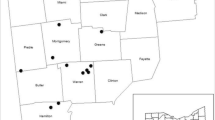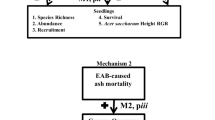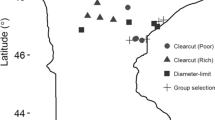Abstract
Emerald ash borer (EAB; Agrilus planipennis) has killed millions of ash trees and threatens ash throughout North America, and long-term persistence of ash will depend on the potential for regeneration. We quantified ash demography, including mortality and regeneration, of Fraxinus americana (white ash), Fraxinus pennsylvanica (green ash), and Fraxinus nigra (black ash) in mixed hardwood forests near the epicenter of the EAB invasion in southeastern Michigan and throughout Ohio. Plots were established across a gradient of ash densities. Ash was the most important species in hydric sites, and ranked second among all species in mesic and xeric sites. In sites nearest the epicenter in Michigan, ash mortality exceeded 99 % by 2009, and few or no newly germinated ash seedlings were observed, leaving only an “orphaned cohort” of established ash seedlings and saplings. As ash mortality increased, the number of viable ash seeds in soil samples decreased sharply, and no viable seeds were collected in 2007 or 2008. In Ohio sites farther from the epicenter, densities of new ash seedlings were much higher in plots with healthy ash trees compared to plots where trees had died. EAB was still present in low densities in Michigan and Ohio stands in 2012 where average mortality of ash was nearly 100 %. The future of ash at these sites will depend on the outcome of the dynamic interaction between the orphaned cohort of previously established ash seedlings and saplings and low density EAB populations.






Similar content being viewed by others
References
Anulewicz AC, McCullough DG, Cappaert DL (2007) Emerald ash borer (Agrilus planipennis) density and canopy dieback in three North American ash species. Arboric Urban For 33:338–349
Barnes BV (1976) Succession in deciduous swamp communities of southeastern Michigan formerly dominated by American elm. Can J Bot 54:19–24
Baskin CC, Baskin JM (1998) Seeds: ecology, biogeography, and evolution of dormancy and germination. Academic Press, San Diego
Bauer L, Gould J, Duan J, et al. (2010) Emerald ash borer biological control. In: McManus K, Gottschalk KW (eds) 21st US Department of Agriculture Interagency Research Forum on Invasive Species. USDA Forest Service, Annapolis, pp 70–73
BenDor TK, Metcalf SS, Fontenot LE et al (2006) Modeling the spread of the emerald ash borer. Ecol Model 197:221–236
Boerner REJ, Brinkman JA (1996) Ten years of tree seedling establishment and mortality in an Ohio deciduous forest complex. Bull Torrey Bot Club 123:309–317
Bonner FT (2008) Fraxinus L. ash. In: Bonner FT, Karrfalt RP (eds) The woody plant seed manual. Agricultural handbook 727. US Department of Agriculture, Forest Service, Washington, pp 537–543
Burns RM, Honkala BH (1990) Silvics of North America: 1. Conifers; 2. Hardwoods. Agriculture handbook 654. 2. US Department of Agriculture, Forest Service, Washington
Cappaert D, McCullough DG (2009) Occurrence and seasonal abundance of Atanycolus cappaerti (Hymenoptera: Braconidae) a native parasitoid of emerald ash borer, Agrilus plonipennis (Coleoptera: Buprestidae). Great Lakes Entomol 42:16–29
Cappaert DL, McCullough DG, Poland TM et al (2005) Emerald ash borer in North America: a research and regulatory challenge. Am Entomol 51:152–165
Cardina J, Sparrow DH (1996) A comparison of methods to predict weed seedling populations from the soil seedbank. Weed Sci 44:46–51
Clark FB (1962) White ash, hackberry, and yellow-poplar seed remain viable when stored in the forest litter. Proceed Indiana Acad Sci 72:112–114
Crosthwaite JC, Sobek S, Lyons DB et al (2011) The overwintering physiology of the emerald ash borer, Agrilus planipennis Fairmaire (Coleoptera: Buprestidae). J Insect Physiol 57:166–173
D’Amato AW (2010) Silvicultural options for black ash communities facing the threat of emerald ash borer. Black ash symposium. USDA Forest Service. Bemidji. http://www.fs.usda.gov/Internet/FSE_DOCUMENTS/stelprdb5191802.pdf
Dietze MC, Clark JS (2008) Changing the gap dynamics paradigm: vegetative regeneration control on forest response to disturbance. Ecol Monogr 78:331–347
Duan JJ, Bauer LS, Abell KJ et al (2012) Population responses of hymenopteran parasitoids to the emerald ash borer (Coleoptera: Buprestidae) in recently invaded areas in north central United States. Bio Control 57:199–209
Ellis RH, Hong TD, Roberts EH (1985) Handbook of seed technology for genebanks II. Compendium of specific germination information and test recommendations. International Board for Plant Genetic Resources, Rome
Eschtruth AK, Cleavitt NL, Battles JJ et al (2006) Vegetation dynamics in declining eastern hemlock stands: 9 years of forest response to hemlock woolly adelgid infestation. Can J For Res 36:1435–1450
Faanes CA (1984) Wooded islands in a sea of prairie. Am Birds 38:3–6
Flower CE, Knight KS, Rebbeck J et al (2013) The relationship between the emerald ash borer (Agrilus planipennis) and ash (Fraxinus spp.) tree decline: using visual canopy condition assessments and leaf isotope measurements to assess pest damage. For Ecol Manag 303:143–147
Franklin JF, Spies TA, Pelt RV et al (2002) Disturbances and structural development of natural forest ecosystems with silvicultural implications, using Douglas-fir forests as an example. For Ecol Manag 155:399–423
Gandhi KJK, Herms DA (2010a) Direct and indirect effects of alien insect herbivores on ecological processes and interactions in forests of eastern North America. Biol Invasions 12:389–405
Gandhi KJK, Herms DA (2010b) North American arthropods at risk due to widespread Fraxinus mortality caused by the alien emerald ash borer. Biol Invasions 12:1839–1846
Griffith RS (1991) Fraxinus americana. In: Fire effects information system (online). USDA Forest Service, Rocky Mountain Research Station, Fire Sciences Laboratory, p 32
Gucker CL (2005a) Fraxinus nigra. In: Fire effects information system (online). USDA Forest Service, Rocky Mountain Research Station, Fire Sciences Laboratory, p 32
Gucker CL (2005b) Fraxinus pennsylvanica. In: Fire effects information system (online). USDA Forest Service, Rocky Mountain Research Station, Fire Sciences Laboratory, p 32
Hyatt LA, Casper BB (2000) Seed bank formation during early secondary succession in a temperate deciduous forest. J Ecol 88:516–527
Kennedy HE (1990) Fraxinus pennsylvanica Marsh. green ash. In: Burns RM, Honkala BH (eds) Silvics of North American. Agricultural handbook, vol 654. US Department of Agriculture, Forest Service, Washington, pp 348–354
Klooster WS (2012) Forest responses to emerald ash borer-induced ash mortality (Doctoral dissertation). The Ohio State University, Columbus, p 205
Knight KS, Herms DA, Plumb R, et al. (2012) Dynamics of surviving ash (Fraxinus spp.) in areas long infested by emerald ash borer (Agrilus planipennis). In: Sniezko R, Yanchuk A, Kliejunas J, Palmieri K, Alexander J, Frankel S (eds) Proceedings of the 4th international workshop on the genetics of host-parasite interactions in forestry: disease and insect resistance in forest trees. Eugene. Genetics technical report PSW-GTR-240. US Department of Agriculture, Forest Service, Pacific Southwest Research Station, Albany, pp 143–152
Kurmis V, Kim JH (1989) Black ash stand composition and structure in Carlton County, Minnesota. Department of Forest Resources Staff Paper Series, no. 69. University of Minnesota, Twin Cities
Leak WB (1963) Delayed germination of white ash seeds under forest conditions. J For 61:768–772
Lesica P (2001) Recruitment of Fraxinus pennsylvanica (Oleaceae) in eastern Montana woodlands. Madroño 48:286–292
Liu H, Bauer LS, Gao R et al (2003) Exploratory survey for the emerald ash borer, Agrilus planipennis (Coleoptera: Buprestidae), and its natural enemies in China. Great Lakes Entomol 36:191–204
Lovett GM, Canham CD, Arthur MA et al (2006) Forest ecosystem responses to exotic pests and pathogens in eastern North America. Bioscience 56:395–405
MacFarlane DW, Meyer SP (2005) Characteristics and distribution of potential ash tree hosts for emerald ash borer. For Ecol Manag 213:15–24
Marquis DA (1975) Seed storage and germination under northern hardwood forests. Can J For Res 5:478–484
Martin AC, Zim HS, Nelson AL (1951) American wildlife and plants: a guide to wildlife food habits. Dover Publications, Inc., New York
McCullough DG, Schneeberger NF, Katovich SA (2008) Emerald ash borer pest alert. NA-PR-02-04. USDA Forest Service
Orwig DA (2002) Ecosystem to regional impacts of introduced pests and pathogens: historical context, questions and issues. J Biogeogr 29:1471–1474
Palik BJ, Ostry ME, Venette RC et al (2012) Tree regeneration in black ash (Fraxinus nigra) stands exhibiting crown dieback in Minnesota. For Ecol Manag 269:26–30
Parker GR, Leopold DJ (1983) Replacement of Ulmus americana L. in a mature east-central Indiana woods. Bull Torrey Bot Club 110:482–488
Peters J (2005) Tetrazolium testing handbook. Handbook on seed testing, 6th edn. Association of Official Seed Analysts
Pickett STA, McDonnell MJ (1989) Seed bank dynamics in temperate deciduous forest. In: Leck MA, Parker VT, Simpson RL (eds) Ecology of soil seed banks. Academic Press, San Diego, p 462
Poland TM, McCullough DG (2006) Emerald ash borer: invasion of the urban forest and the threat to North America’s ash resource. J For 104:118–124
Pugh SA, Liebhold AM, Morin RS (2011) Changes in ash tree demography associated with emerald ash borer invasion, indicated by regional forest inventory data from the Great Lakes States. Can J For Res 41:2165–2175
Rebek EJ, Herms DA, Smitley DR (2008) Interspecific variation in resistance to emerald ash borer (Coleoptera: Buprestidae) among North American and Asian ash (Fraxinus spp.). Environ Entomol 37:242–246
Reiners WA, Reiners NM (1970) Energy and nutrient dynamics of forest floors in three Minnesota forests. J Ecol 58:497–519
Richardson CJ, Cares CW (1976) An analysis of elm (Ulmus americana) mortality in a second-growth hardwood forest in southeastern Michigan. Can J Bot 54:1120–1125
Sawma JT, Mohler CL (2002) Evaluating seed viability by an unimbibed seed crush test in comparison with the tetrazolium test. Weed Technol 16:781–786
Schlesinger RC (1990) Fraxinus americana L. white ash. In: Burns RM, Honkala BH (eds) Silvics of North America. Agricultural handbook, vol 654. US Department of Agriculture, Forest Service, Washington, pp 333–338
Siegert NW, McCullough DG, Liebhold AM, et al. (2008) Dendrochronological reconstruction of the establishment and spread of emerald ash borer. In: Mastro V, Lance D, Reardon R, Parra G (eds) Emerald ash borer research and development meeting. Pittsburgh, PA. FHTET 2008–2007. US Department of Agriculture, Forest Service, Forest Health Technology Enterprise Team, Morgantown, pp 4–5
Smith A (2006) Effects of community structure on forest susceptibility and response to the emerald ash borer invasion of the Huron River Watershed in southeastern Michigan (Master’s thesis). The Ohio State University, Columbus, p 122
Tanis SR, McCullough DG (2012) Differential persistence of blue ash and white ash following emerald ash borer invasion. Can J For Res 42:1542–1550
US Forest Service (2007) Forest inventory and analysis national core field guide, vol 1. Field data collection procedures for phase 2 plots. Version 4.0. Available from http://www.fia.fs.fed.us/library/field-guides-methods-proc/docs/2013/Core%20FIA%20P2%20field%20guide_6-0_6_27_2013.pdf. Accessed 28 February 2012
Whitehill JG, Herms DA, Bonello P (2009) Comparative constituitive and induced phloem chemistry of North American, European, and Asian ash species that vary in resistance to emerald ash borer. In: Lance D, Buck J, Binion D, Reardon R, Mastro V (eds) Emerald ash borer research and technology development meeting. Forest Health Technology Enterprise Team, Pittsburgh, pp 56–57
Wright JW, Rauscher HM (1990) Fraxinus nigra Marsh. black ash. In: Burns RM, Honkala BH (eds) Silvics of North America. Agricultural handbook, vol 654. US Department of Agricuture, Forest Service, Washington, pp 344–347
Acknowledgments
For their extensive assistance with field and laboratory work we thank Limbania Aliega, Lourdes Arrueta, Stephanie Blumer, Alejandra Claure, Christian Colindres, Kyle Costilow, Tara Dell, Mary Douglas, Eileen Duarte, Charles Flower, Stefanie Fluke, Tim Fox, Joan Jolliffas, Lawrence Long, Rina Mejía, Rachel Nieswander, Sarahí Nuñez, Delmy Sánchez, Sebastián Sáenz, Stephanie Smith, and Nathan Yaussy, as well as other members of the Herms, Knight and McCullough Labs. We are especially grateful to Diane Hartzler who organized and coordinated much of the field work in Michigan since the inception of the study. We also thank the two anonymous reviewers for their constructive suggestions that helped us improve this manuscript. This research was funded by grants from the USDA Forest Service Northeastern Research Station’s Research on Biological Invasions of Northeastern Forests program; USDA National Research Initiative Biology of Weedy and Invasive Species in Agroecosystems competitive grants program; the National Institute of Food and Agriculture; Cooperative Agreements with the USDA Forest Service Northern Research Station, Delaware, OH; and state and federal funds appropriated to the Ohio Agricultural Research and Development Center and The Ohio State University.
Author information
Authors and Affiliations
Corresponding author
Rights and permissions
About this article
Cite this article
Klooster, W.S., Herms, D.A., Knight, K.S. et al. Ash (Fraxinus spp.) mortality, regeneration, and seed bank dynamics in mixed hardwood forests following invasion by emerald ash borer (Agrilus planipennis). Biol Invasions 16, 859–873 (2014). https://doi.org/10.1007/s10530-013-0543-7
Received:
Accepted:
Published:
Issue Date:
DOI: https://doi.org/10.1007/s10530-013-0543-7




